|
28th July 2014, Wenlock Edge and Coalbrookdale
The orchid season for 2014, so it is time to have a look at some Violet Helleborines. These two Shropshire sites are close enough together for a double visit. At Wenlock Edge we failed to see the few plants seen in 2013, but a walk along the Shropshire Way as far as the Major's Leap path was long enough for us to catch about 10 of them without straying from the path. Most are growing singly, and none have open flowers yet.
Walking back along the top path half the journey is above a limestone quarry. In the fenced off part there are some orchids that have finished flowering; a possible Marsh Orchid, and some more identifiable Pyramidals and Bees. Worth a visit next year in late June perhaps.
At Coalbrookdale they were just opening, but seemed a few less than last year, even taking into consideration those that had their flower heads removed.
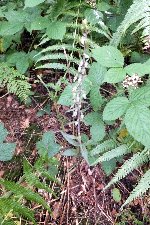 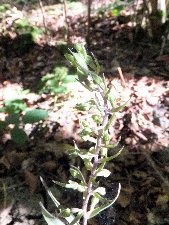 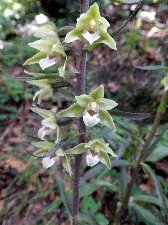 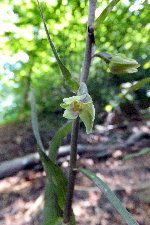
Wenlock Edge Coalbrookdale
27th July 2014, Alyn Waters
The last visit to the country park and we see the Fragrant Orchids on their last legs, the Bee Orchids producing seed, the Twayblade leaves yellowing, and a Dune Helleborine with variegated leaves! But essentially the trip was for the Green-flowered Helleborines. I am still undecided as to whether those here are var pendula or var degenera, or both. Naturally what we see confirms none of this. Look at the pictures, and you can see flowers resembling both forms, but nothing definite.
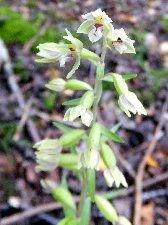 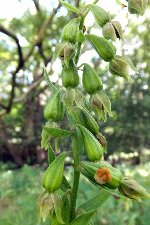 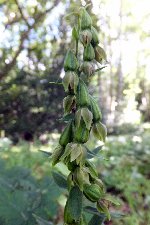 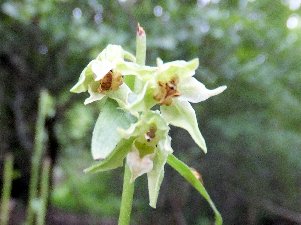 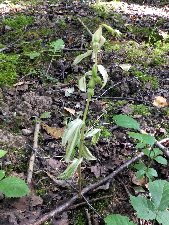
26th July 2014, Elan Valley Estate
Working with positive information as to exactly where, and I do mean exactly, we set off to find the Bog Orchid at Pont ar Elan, right at the tip of the most northern of the Elan Valley lakes. Without that information we would not have stood a chance! They are so small and inconspicuous, despite their rather pallid lime green colour. We were told there was a largish single plant, and a colony of 13 nearby. The large one was difficult enough, and we struggled to locate the colony, eventually find just another single plant in a boggy reedy patch. The large plant had a smaller child right adjacent to it. We found it hardly surprising that this orchid is rare, with its exacting demands as to where to grow, but also its numbers must be underestimated because it is so difficult to spot.
Beware of Sheep Ticks!
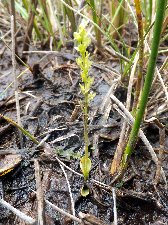 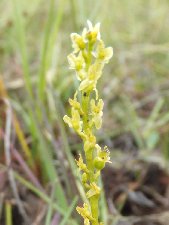 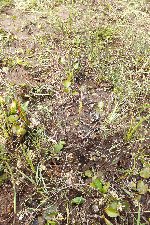 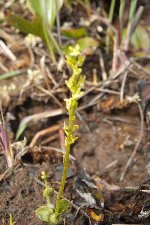
the second plant the flower close up as it grows! the mother and baby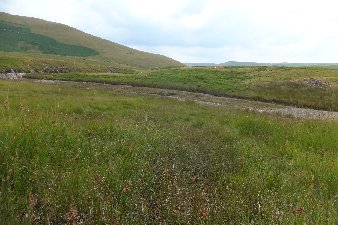
20th July 2014, Marford Woods
The Broad-leaved Helleborines are now fully flowering. I have returned hoping to find the var viridifora (what may be termed an albino variety) which had been seen in 2012. I thought I had actually found it, but an examination of the photos later showed just a smidgeon of pinkish anthocyanin colouration. Here I have a bit of philosophical thought. Is the variety a mutation that lacks the gene for this pigment, or is the gene for anthocyanin activated from full activity down to 0%, on a sliding scale, by various means? If the latter then my plant is virtually a viridiflora.
Another flower is covered with aphids, and these are being `tended' by red ants, but the real curiosity is a group of BLH showing signs of autogamy (self-pollination). Only one flower out of all of them showed crumbling pollinia, but the flowers seem to be going over without opening fully, and the ovaries are hairless and swelling before the flower has died. A return visit next year may show whether these plants are selfing types, or whether this was a one-off phenomenon perhaps the result of early 2014 flowering and a lack of available pollinators.
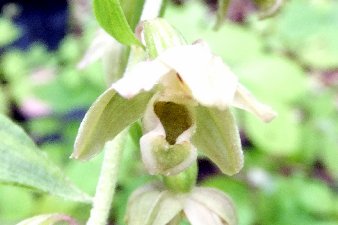 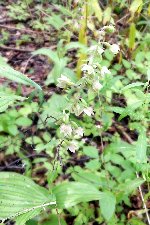
The var viridiflora very nearly
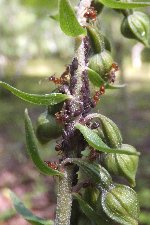 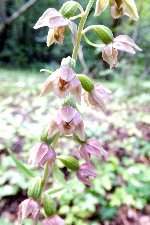
the ants and a rather nice rose colour
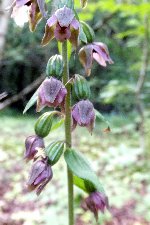 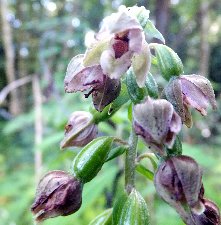 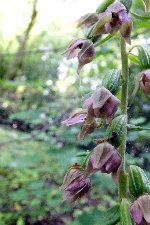
self-polinating?
18th July 2014, Cragside
I didn't expect much from a trip to this NT estate near Morpeth, and I wasn't wrong. Just the occasional Common Spotted and probably Northern Marsh Orchid well past flowering time.
17th July 2014, Killingworth Churchyard
Off to a site which is said to be home to another Tyneside Helleborine specialty; Young's Helleborine. This was originally described as new species of Epipactis, but DNA analysis shows that at each site, both near Newcastle and in Lanarkshire, these plants are variants of the local Broad-leaved Helleborines growing typically on or near old coal spoil tips. As such they are now considered `eco-variants'. Still worth a search for in my opinion.
The Killingworth site is actually the village churchyard; a rather odd place with the graves covered with vegetation and scrub, and larger open grassy areas. The Helleborines were found on the west side, near the boundary wall, and nearby. We counted 25 flowering spikes. Most were a rather pale neutral colour but a couple were pale rose.
Youngs is said to differ from the typical plants by the flowers seemingly more geared up autogamy with a small viscidium and crumbling pollina, while the ovary starts to swell early. The flower is said to be box-like with the sepals and petals bend forward. Other difference include a lower leaf that is longer than broad, and hairless ovaries. Despite the structural evidence for self-pollination the DNA analysis shows the diversity of cross-pollination. Could this be a relic of a recent origin for these colonies? These differences can be seen in the pictures.
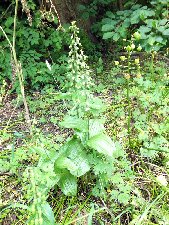 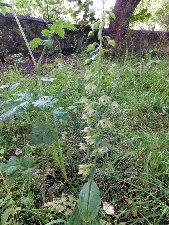 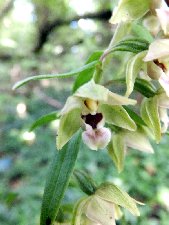 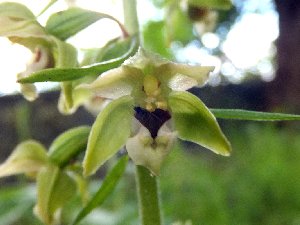
plant showing lower leaf box-like flowers on stem typical flower crumbling pollinia .
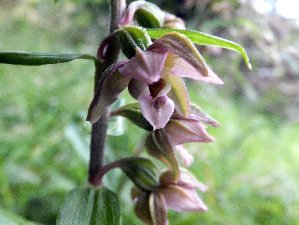 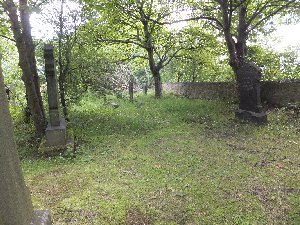
rose coloured with swollen ovaries the site of the largest colony
17th July 2014, Close House Riverside
Just off the former Wylam Colliery Wagonway path, and adjacent to George Stephenson's birthplace is this long narrow reserve running alongside the River Tyne. As such the soil is heavy with zinc, lead and cadmium; ideal for the Tyne Helleborine, a sub-species of the Dune Helleborine, which favours the calaminarian grassland of the flood plains of the river. The metal contamination is derived from old mining operations upstream in the hills.
The Helleborines were found just off the path growing in beechwoods, perhaps the original habitat of E. dunensis. I stopped counting after finding 100 in this one area. Many of those seen were of a good size, with one reaching a height of 95 cm with 40 flowers. The Tyne Helleborine differs from the regular Dune Helleborine by a number of features, including drooping leaves, longer bracts, more open flower with the lip less curved back, and more greenish sepals.
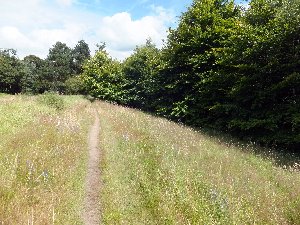 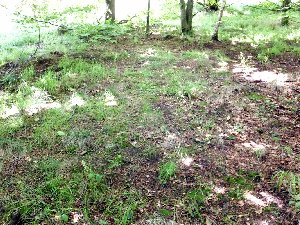
the orchid site from the path and within the trees
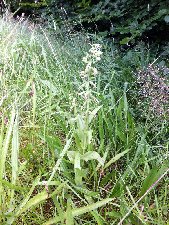 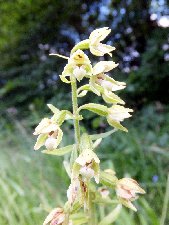 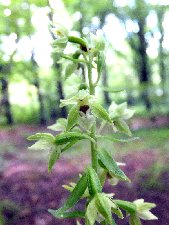 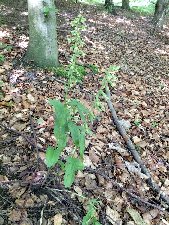 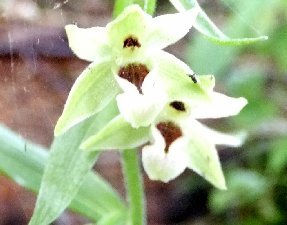
16th July 2014, Lindisfarne
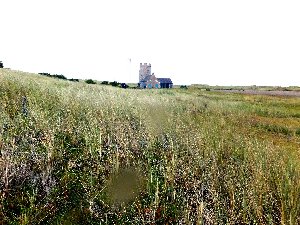 While Lindisfarne, despite its size, has many charms and much to see, I was primarily interested in just one - and the wild, wet, and windy weather of July was not going to deter me. I had received some directions for the Lindisfarne Helleborine, but the caged plant near the Snook car-park was no-where to be seen, and a look across at the area showed us that we may have to wander through several acres of dunes before we got lucky. In actual fact we were successful after about 40 minutes searching, and much of that time was spent working our way along the dunes and looking at what else grew in the slacks. While Lindisfarne, despite its size, has many charms and much to see, I was primarily interested in just one - and the wild, wet, and windy weather of July was not going to deter me. I had received some directions for the Lindisfarne Helleborine, but the caged plant near the Snook car-park was no-where to be seen, and a look across at the area showed us that we may have to wander through several acres of dunes before we got lucky. In actual fact we were successful after about 40 minutes searching, and much of that time was spent working our way along the dunes and looking at what else grew in the slacks.
The Helleborines were found on the west facing side of the dunes, behind and to the left of the tower. There were only seven in total, and just in the final throws of flowering, with just the top ones open. Nevertheless they were found and seen, even though I was a week late to see them at their finest.
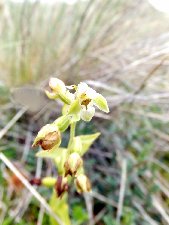 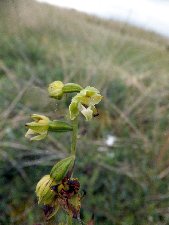 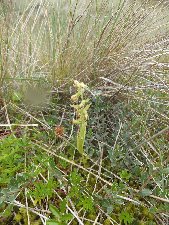
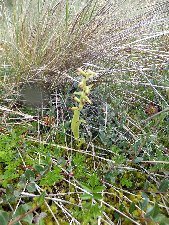 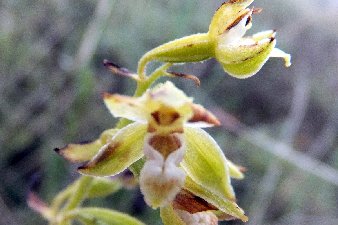
There were other orchids present; some nicely deeply coloured Pyramidal Orchids in the dunes, but the Northern Marsh Orchids and the Marsh Helleborines in the slacks were also at the end of their flowering periods. The was one interesting Pyramidal Orchid with upside down flowers! The flowers are upside down when the flower is in bud and normally twist round upon opening. Very occasionally this mechanism fails and create what is known as a resupinate form.
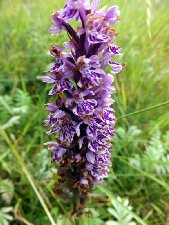 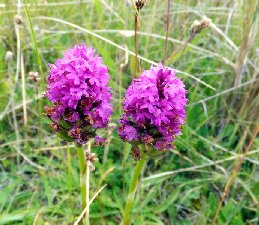 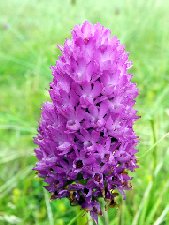
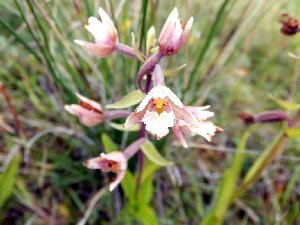
A search for Coral-root Orchids in a rather damp slack where they are known to grow was fruitless. Either we were way too late for them, they hadn't flowered in 2014 due to the wet spring, or we were not in the right place.
A tip for those planning a visit there. Wear wellies regardless of how dry or damp it is. The dunes are infested with piri-piri burr, which attaches itself to any fabric or fabric-like clothing. You should remove any attached to you to prevent its spread, which can take 30 minutes if you are diligent. It has a special liking for shoelaces. If you are wearing canvas footwear you can end up looking like you have hobbit-feet after walking through the slacks. We had to rescue a lark while was immobilised on the ground covered with these awful burrs.
12th July 2014, St Mary's Nature Reserve
Located on the Northumbrian coastline, north of Whitley Bay, this is mainly a reserve for the birdlife. However, in the `Rifle Butt Depressions' are some Common Spotted and Northern Marsh Orchids. Unfortunately both were at the end of their flowering and so photographs would add no value.
12th July 2014, Bishop Middleham Quarry, Durham
This is a former magnesian limestone quarry, close in 1934 and now managed as an SSI by the Durham Wildlife Trust. It is a world famous site for Dark Red Helleborines, and said to have more of them growing here than the rest of the UK put together. I can believe that having managed to take a single photo with more of them, all in a mature state, than I saw in total on Great Orme. A census in 2010 recorded 1700 plants. They grow not only inside the quarry, but are also quite apparent as you enter the site ad across the top level. I will let the photographs speak for themselves, but must add that there are a good number of mature plants exceeding 60 cm in height with more than 20 flowers on the spike. Just one plant showed any variation, having more rusty coloured sepals and lip.
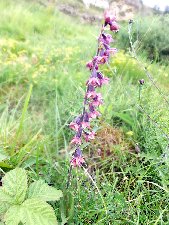 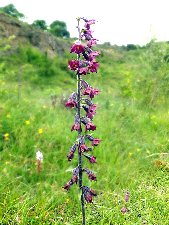 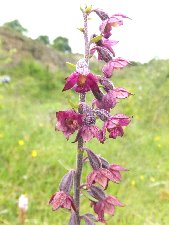 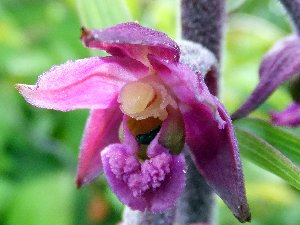
Some typical mature plants, and a close-up of a single flower
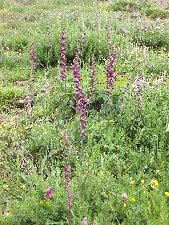 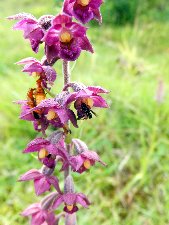 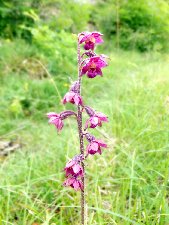
A large group some insect visitors wide open flowers
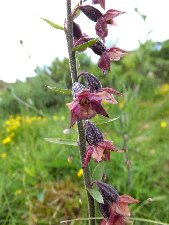 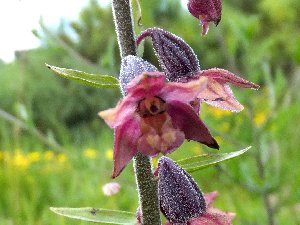
the rusty/yellow coloured variety
The quarry is not limited to just these orchids. We also saw some Common Spotted Orchids, Common Twayblades, Pyramidal Orchids and Marsh Fragrant Orchids; though the latter may have been represented by two species. Most are typical densely flowing Marsh Fragrants, but there is a very pale pink variety, and a more pale lilac plant. But most interestingly were two growing side by side along the top, which stand out as completely different plants. I am tending towards the very pale flowered plant and the pinker, second, flower of the pair being Heath Spotted Orchids. The side petals on the pale one are deflexed downward, a trait not seen in the Marsh Fragrant, while the lobes on the lip of the other flower are poorly defined. There could well be some mixed ancestry in one or both of these plants.
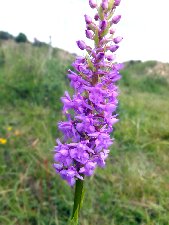 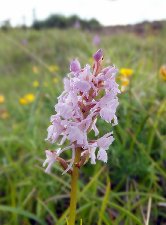 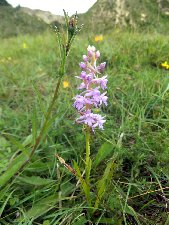
the typical the very pale the pale lilac
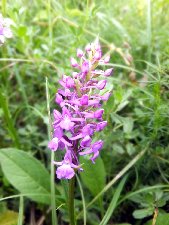 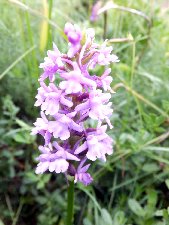
the contrasting pair
Some of the Common Spotteds almost lack any colouration being virtually pure white (these tending to be quite small plants about 10 cm tall), while the Twayblades have a nice golden yellow colour.
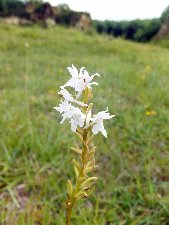 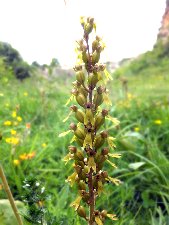
On the north to Northumbria a hold up at the end of the M1 allowed me notice and identify a colony of (Marsh) Fragrant Orchids growing on the northbound side at junction 44; a nice change from roadside Common Spotted Orchids.
|
